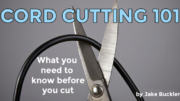By now you’ve probably read our tutorial on combining two antennas. It’s one of the most popular articles in our history. Is it really the better way to go, though? Or, will a simple antenna amplifier do a better job for you? Let’s take a look.
What’s the point?
Whether it’s amplifying or adding hardware, the reason is the same: more signal. Specifically, more gain. We want better reception, we want to be able to pick up signals we couldn’t pick up before. In order to do that, we need more of something. I like to tell people that RF signals are like butterflies and an antenna is like a net. The easiest way to catch more of them is with a bigger net.
I admit that’s not a perfect analogy because it’s not enough to make an antenna bigger just to make it bigger. It has to be bigger in just the right way. Broadcasts are all on “frequencies” and “frequencies” translate out to “wavelengths.” I put all these terms in quotes because it’s not about your deep understanding of the physics behind it all. It’s about understanding that the higher the frequency (or the channel number, in the case of TV) the shorter the wavelengths get. And, an antenna does its best work when its physical size is matched up to the length of the wave it’s trying to receive.
If you look at at it that way, two or four antennas should pick up a lot more signal. And they do, if they’re put together right. An array of two antennas should pull in double the signal, and an array of four should pull in four times the signal. That’s the idea behind our Xtreme Signal HDB8X. It’s easy to see that it’s really four smaller antennas put together. Combined, they give you about 17dB of gain.
And then there are amplifiers.
An amplifier takes a signal from an antenna (or anything, really) and adds to it. It’s pretty common for amplifiers to have up to 20dB of gain. All you have to do is put it inline with the antenna and plug it in. It’s a lot simpler than wiring up two antennas. It’s usually less expensive too.
More gain is better gain, unless…
Here’s the difference. An antenna can amplify the signal, but that doesn’t work the way you tend to think it does. Digital signals respond to amplification differently from analog ones. If you want to really understand the way they work, you’ll want to look at this deep dive article. The bottom line, though, is that amplifying a digital signal doesn’t necessarily help you. If the signal isn’t received by the antenna in the first place, adding an amplifier isn’t going to help.
In fact, the one and only reason to use an amplifier is to compensate for the loss of signal over a cable. In practice, an amplified antenna may deliver more signal to your TV, but the amount of signal it receives is the same whether it’s amplified or not.
The old-schoolers say…
Ask your typical grizzled antenna veteran and he will tell you that the better way to go is to add more antennas. This is going to pull in the weakest of the weak signals. Another option is a truly giant antenna but sometimes those are hard to come by.
However, that veteran would be well versed in making his own cables and making sure that everything is properly spaced. That’s critical to avoid “phasing” issues where the signal from one antenna cancels out the signal from another. If you’re good at that stuff, it’s easy. If you’re not, it can be a big issue.
An array of multiple antennas is going to give you the best chance of pulling in truly weak signals. It’s just up to you to decide if you can make it happen. You’ll need to make sure you do it right, and account for all the loss that comes with combining multiple antennas. I covered that in detail here, if you’re curious.
The modern solution
A lot of people use amplifiers today instead of using multiple antennas. This means the antenna itself can be smaller and you will still get some benefit from the extra gain. Smaller antennas look better to many people and you won’t run afoul of the homeowners association. The HOA or condo board has the right to complain if your antenna gets bigger than 39″ in any direction. So, while an amplifier might not be a perfect solution… like a lot of things today it’s a good compromise.
Whether you need more antennas or antenna amplifiers, you’ll find the best of everything at SolidSignal.com. You’ll even find all the accessories you need to make whatever sized array you want. If you’re not sure what you need, why not call the experts? We’re here for you during East Coast business hours. When you call 888-233-7563, you’ll reach a real, certified antenna technician. They’ll help explain everything to you. If it’s after hours, no problem! Fill out the form below. Our team will get right back to you!





